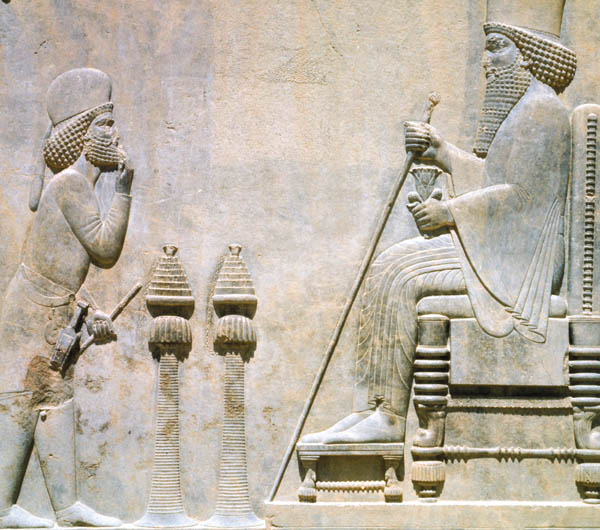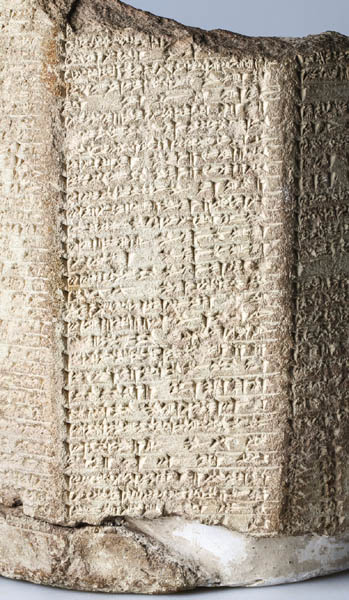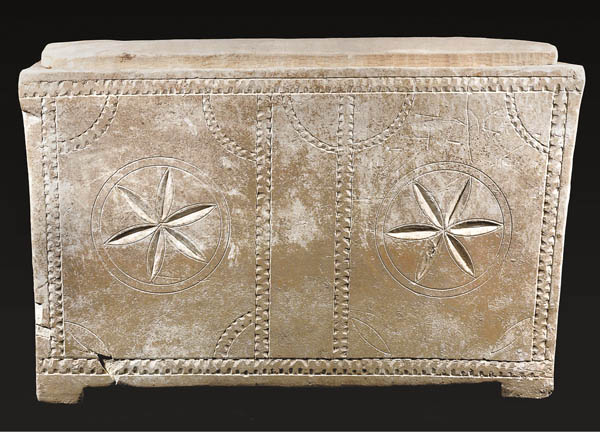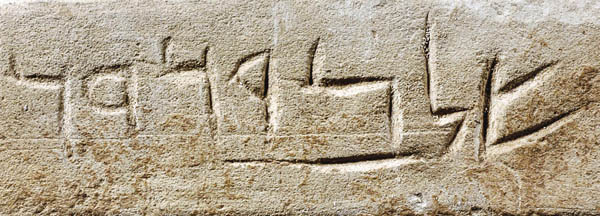In the March/April 2014 issue of BAR, I wrote an article on 50 people in the Hebrew Bible whose existence has been confirmed by archaeology.a At the end of the article, in a box, I also listed seven additional people. They had not three, but only two, attributes matching the Biblical person, so their identifications were not certain but were reasonable hypotheses.
Now I am pleased to report on three new people added to the 50 confirmed (of whom two have already been mentioned in BARb), and three new people added to the seven uncertain but reasonable identifications. At the end are a few interesting non-identifications.
Strongly Identified
The first real person to be added to the original list of 50 is the Biblical Tattenai (also translated Tatnai or Sisinnes), mentioned in Ezra 5:3, etc. He was the Persian governor of the province of Trans-Euphrates—literally, “Beyond-the-River,” which for the Persians meant their territory west of the Euphrates River. There are strong grounds for identifying Biblical Tattenai in a tablet of Darius I the Great, king of Persia, which can be dated to exactly June 5, 502 B.C.E. First, the letter on this tablet, which was recovered from Babylon, has long been accepted as authentic. Second, the setting (time and place) of the Tattenai in the tablet was in Trans-Euphrates during the reign of Darius I (r. 520–486 B.C.E.). That territory included Yehud (roughly equivalent to Judah, but under Persian rule), which matches the setting of the Tattenai in the Book of Ezra chapters 5 and 6. Ezra’s Tattenai appears in Jerusalem during the last few years before the completion of the Second Temple around 516 B.C.E. Third, only one person named Tattenai would have been the Persian governor of Trans-Euphrates between 520 and 502 B.C.E. It is extremely unlikely that two different men having exactly the same name would both be governors over Trans-Euphrates, and specifically Yehud, during this very narrow time period, so that possibility is negligible. Therefore, the identification of the Biblical Tattenai in Darius I’s letter of 502 is based on singularity: One and only one person qualifies.
The next two of the three additional, strongly identified persons are Nergal-sharezer and Nebuzaradan, high officials of Nebuchadnezzar II, the king of Babylon who in 586 B.C.E. destroyed the First Temple as well as Jerusalem and exiled much of the remaining population of Judah.c These two people are both named in a Babylonian cuneiform inscription (published in 1931 and well known) that lists Nebuchadnezzar’s courtiers.
Ironically, both of these Assyrian mighty men fell victim to a publication deadline. After submitting the article “Archaeology Confirms 50 Real People in the Bible” to BAR, I later sent the message to add these two people to the article, but it had already gone to press, so they did not appear in the article.
The first of these officials is called Nergal-sharezer the Samgar in Jeremiah 39:3, which is a fair Hebrew approximation of his name and title in Babylonian Akkadian: Nergal-sharuṣur the Sin-magir.
The Bible renders the name and position of the second official, also an officer of King Nebuchadnezzar II, as Nebuzaradan (2 Kings 25:8; Jeremiah 39:9; etc.), again a close Hebrew approximation of his Babylonian name, in this case Nabuzeriddinam. Various translations give his title as “chief cook” or “chief of the guards.” One may speculate that perhaps he functioned partly as a logistics officer in charge of feeding the exiles, as well as the army, on their long trek to the Babylonian homeland.

Both of these men were officers of Nebuchadnezzar II, according to Jeremiah 39 (Nebuzaradan is also mentioned as such in 2 Kings 25). Their names and titles as rendered in Hebrew correspond recognizably with their Babylonian names and titles in the inscription, and it is most unlikely that in either case, some other man with the same name occupied the same office during the reign of the same king. This unlikelihood is multiplied by the fact that both men are named together in Jeremiah and together in the Babylonian inscription. In both instances, one and only one person has this name and this title in the extremely limited setting of the court of this king. Therefore, as with Tattenai, both are strongly identified on the basis of singularity.

Not Certain, but Reasonable
Shifting away from strong identifications, now we’ll consider those in a weaker category: reasonable hypotheses (while avoiding circular logic):1
In 1 Chronicles 24:7—19 is a list of the heads of 24 priestly families appointed to take turns performing priestly duties in the Temple, including Jakim in verse 12 and Hezir in verse 15.
An epitaph (tomb inscription) fulfills the purpose of a “sign” over a large family tomb complex in the Kidron Valley (just outside of Jerusalem toward the east), on the western slope of the Mount of Olives, facing the site of the Temple. First it names some of Ḥezîr’s prominent descendants, and then it presents Ḥezîr by name in the final phrase, which refers to his descendants, that is, all who are named before that, as “priests, of the sons of Ḥezîr.” This particular way of saying it recognizes him as the head of that priestly family. The location of the tomb complex and the Yahwistic names of his descendants, buttressed by the Hebrew square script of the epitaph, make it clear that the inscriptional Ḥezîr was a Hebrew priest who at some point most likely served in the Jerusalem Temple. To be sure, the inscriptional Ḥezîr’s name, his official designation as a priest, and his status as the recognized head of a priestly family are three identifying marks (attributes) of an individual that correspond to the same three marks in 1 Chronicles 24:15. Then why isn’t this a strong identification?
The difficulty is with the basic time requirement of the setting (time and place). The inscription does not supply enough information to assign even an approximate century to the Ḥezîr in the inscription. This makes it impossible to date him within about 50 years of the Biblical Hezir in 1 Chronicles 24:15, who according to Biblical chronology lived during the lifetime of King David, in the last years of the 11th and in the early 10th centuries B.C.E. Because of the unknown time element, there exists the possibility that the Ḥezîr in the inscription might be a different priest, perhaps a descendant of the Biblical Hezir, and possibly even named after him. Although the match is not strong enough to qualify this as a strong identification, this classification recognizes the clear similarities and that the inscription might, on grounds that are quite reasonable, refer to the Biblical Hezir, especially in recognition of the continuity of ancient Hebrew tradition in Second Temple Jewish culture.
Inside the Ḥezîr family tomb complex, a square stone plate was discovered lying broken into fragments. It had been used to seal a burial there. On it is inscribed, in four lines: “The house of the bones of ‘Obadiya[h], son of G… Ḥezîr.” The fact that the last word (line 4) is the name Ḥezîr, in light of the final mention of him in the epitaph over the tomb complex, suggests that it is “probably … a general family identification.”2
Similarly, an inscription on an ossuary (“bone box”) of the first or second century C.E. discovered in a burial chamber just outside Jerusalem presents Yakîm by name in a way that recognizes him as a priest and the head of another priestly family. The three-line inscription reads: “Menahem, from the sons of Yakîm, (a) priest.” As in the case of Ḥezîr, the location on the western slope of the Mount of Olives in a tomb facing the Temple of the God of Israel at Jerusalem corresponds to the general location in the Biblical Jakim’s setting as a priest who served in the Temple. Regarding attributes of the individual, (1) the inscriptional name Yakîm matches the Biblical name Jakim, being the same name, simply transcribed into English in a different way; (2) the inscription implies that its Yakîm was a priest because he was the ancestor of a priest; and (3) he is spoken of in a way that recognizes him as the head of a priestly family. These three identifying marks (or attributes) of an individual correspond to the same three marks of the Biblical Jakim in 1 Chronicles 24:12. But again, the inscription does not supply enough information to provide even an approximate century for the Yakîm in the inscription, making it impossible to date him within about 50 years of the Biblical Jakim in 1 Chronicles 24:12. Therefore, as with Ḥezîr, this potential identification cannot be regarded as certain, only as a reasonable hypothesis that fits with an ancient text.
A third identification of this same, reasonable kind can be made in the ossuary inscription “Mariam, daughter of Yeshua‘ bar Qayafa,3 (a) priest from Ma‘aziah from Bet ‘Imri.’ ” This inscription’s most significant difficulty is that it is not provenanced, that is, its origin is unknown. Therefore, it was at first considered a potential forgery. In order to resolve that question, sometime after it came into the possession of the Israel Antiquities Authority in 2008, Boaz Zissu and Yuval Goren conducted a thorough scientific examination of the surface of the stone and its patina (a coating or crust on an outer surface, produced by weathering and microorganisms). Their analysis revealed that “the patina and the inscription that it covers should be considered authentic beyond any reasonable doubt.”
As with the previous reasonable identifications of the heads of priestly families who took turns in performing their duties, there are three attributes, or marks, of Ma‘aziah, the head of the last priestly family named (in 1 Chronicles 24:18) that match the same three attributes in this ossuary inscription: (1) The name is the same in the Bible and in the inscription. It has the ending –yahu in 1 Chronicles 24:18 and the equivalent ending –yah in both Nehemiah 10:8 and in the inscription. The two endings are simply variant spellings of this and many other Biblical names. (2) Both were priests. In the inscription, this is shown by the fact that a male descendant was a priest (Christopher Rollston offered a modest but important correction of the translation, reading “priest” in the singular, instead of “priests”). (3) Both are the recognized heads of a priestly family. Such headship is explicit in 1 Chronicles 24:1—6, and it is implicit in the inscription’s phrasing, which is appropriate for the head of family: “from (Aramaic min) Ma‘aziah.” Bet ‘Imri’ is most likely the name of a “father’s house,” that is, a subset within the priestly family of Ma‘aziah.
Again, the lack of a known match between the setting (time and place) of the Biblical Ma‘aziahu and the inscriptional Ma‘aziah prevents the identification from being logically “airtight” and thus strong. Even the century during which Ma‘aziah lived is left undefined by the inscription. Nevertheless, it must be recognized that the three points of agreement between the Biblical and the inscriptional person are impressive. Therefore, this identification deserves recognition as reasonable, though not demonstrably certain without relying on Biblical data, which, if used to try to show the historical accuracy of the Bible, would create circular logic—relying on the premise that Biblical data are accurate to conclude that the Bible is accurate.


Not Identified, but Worth Noting
As mentioned above, 1 Chronicles 24 names 24 priests who were heads of families that served as priestly courses, taking turns at performing the duties of priests. Among these family heads are listed Eliashib (v. 12) and Jeshebeab (v. 13). Although then, as now, many people had the same given (“first”) name, each of these two names also appears in an inscription that, at first glance, might seem to refer to these particular individuals. Among the Dead Sea Scrolls discovered at Murabba‘at is a marriage contract written in Aramaic (c. 117 C.E.) that refers to a man named ’Eliashîb in a phrase indicating he was a head of a family. Also, a man named Yesheb’ab (this spelling being simply a different transliteration of Jeshebeab) is named in the manner of a head of family on the ossuary of the children of Yeḥzaq discovered in 1912 in the Katamon neighborhood of West Jerusalem. Neither this marriage contract nor this ossuary inscription, however, calls them or their families priests or gives any hint that they were priests. That does not necessarily mean that they were not priests; it simply fails to supply an attribute or mark that would have helped to identify the person. Also, neither inscription indicates the time when either of these two family heads lived. Since they are not designated as priests, they could have been heads of families in practically any of the Israelite tribes, at any period within an undetermined length of time. As a result, neither identification is possible.
In 1973, in the Giv‘at Ha-Mivtar neighborhood of Jerusalem, in a recess cut into rock to form a single-chambered tomb, an ossuary was discovered that was made in either the first century B.C.E. or the first century C.E. It contained the bones of a man about 25 years old. This ossuary has two inscriptions, one on its side and another, tiny inscription on its rim, where the lid rested—an unusual location that is known to have been used only in four other ossuaries. The inscription on its side includes the word shalom, probably meaning the woman’s name Shalom, followed by a name that can be read as either Hillel or Hanan. The rim inscription seems to be ŠLBYDWD. The tentative Š would be a relative pronoun, potentially translatable as “(that) which (is),” or, more appropriately, in this context, “(one) who (is).” The rest of the inscription may tentatively, and without complete assurance, be read as “of the house of David.” According to the Corpus Inscriptionum Iudaeae/Palaestinae, “David as a personal name is otherwise unattested for this period.” Although it would be clearly unreliable to claim certainty for an identification based on a reading that is only tentative, there seems to be some reason for thinking that the rim inscription may refer to a descendant of the Biblical King David. If we were absolutely certain the inscription refers to the Biblical David, however, we would have heard about it long ago! And without other, intervening archaeological confirmations between the “House of David” stele from Tel Dan and this ossuary, it is not very useful as evidence for David’s existence a millennium earlier. Nevertheless, the inscription certainly seems to fit with the Biblical tradition of the continuance of the line of King David.
In sum, we have three more strong identifications in the Hebrew Bible, or Old Testament, for a new total of 53; three more identifications that are not certain but are reasonable hypotheses, for a new total of ten; and three non-identifications that are nonetheless interesting and worthy of mention.
